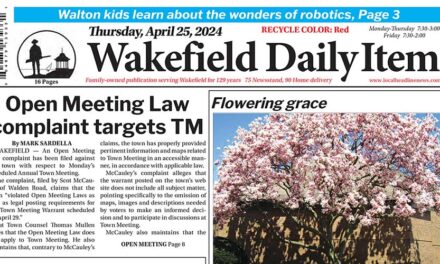Published in the May 24, 2019 edition.
WAKEFIELD — May 26 will mark the 150th anniversary of The Savings Bank, a milestone that is being celebrated with the community throughout the year including their celebration with the community on Saturday, June 22 from 2 to 8 p.m.
“We are excited to be celebrating this significant milestone and to share our extraordinary history with our customers and the community,” President and Chief Executive Office Robert J. DiBella said. “I am humbled and proud to be at the helm of the Bank which was founded and presided over by Cyrus Wakefield, our first President and town benefactor.”
“We look forward to a fun day celebrating with the community on June 22 at the Wakefield Town Commons.”
The first 100 years…
Steeped in history and deeply rooted in the community, the bank was established as the Wakefield Savings Bank by the acts of incorporation approved the Massachusetts Legislature and subsequently signed by Governor Alexander H. Bullock on May 26, 1869. The petition to charter a savings bank was spearheaded by several prominent business leaders including Cyrus Wakefield who was elected President at the Bank’s first meeting on June 12, 1869. Mr. Wakefield, for whom the town was re-named in 1868, was one of the 18 Officers and Trustees who were elected as Corporators that day in a meeting held in the law office of noted Wakefield historian Chester W. Eaton, Esq.
The first banking office of the Wakefield Savings Bank was located in a two-story building perpendicular to the present-day Main Office at 357 Main Street. On June 30, 1869, the Bank’s first day of business, 38 accounts were opened and $3,263 was deposited, mostly by family members. Business was conducted semi-weekly, on Wednesdays and Saturdays, from 2 to 5 p.m. and 6 to 8 p.m.
During the first month in operation, 63 additional accounts were opened and the Bank made its first mortgage loans, one to J. Mansfield for $1,000 and another to Joseph Cartwright for $2,500. At the end of the first year, the Wakefield Savings Bank had 329 accounts with total deposits of $31,698.
Just four short years after its establishment, the Bank elected its second President, James F. Emerson, following the sudden death of Cyrus Wakefield in 1873. Emerson, who served as Town Treasurer, also owned the family’s shoe manufacturing business, Thomas Emerson’s Sons. It was under his presidency that the Bank moved into its second home on the second floor of the newly-built Wakefield Building at the corner of Main and Lincoln Streets, in 1874. Bank deposits and the number of accounts steadily increased during the next two decades, from $67,530 and 667 accounts in 1879 to $803,300 and 3,312 accounts in 1899.
Bank offices were relocated in 1897 to the first floor of the Flanery Block, later re-named the Odd Fellow’s Building, where they remained until 1903. The new home of the Wakefield Savings Bank was built at the corner of Main and Chestnut Streets as a joint undertaking by the Bank and the Wakefield National Bank; each banking institution owned half the lot and half the building, separated by a brick wall from floor to roof. The National Bank owned the southern half, The Savings Bank owned the northern half and the two shared a common entrance.
When the Wakefield National Bank completed its own building on the opposite corner in 1923, the Wakefield Savings Bank bought the entire building and moved into the southern half in 1925, later renting out its previous offices to the Wakefield Municipal Light Department (now the Wakefield Municipal Gas and Light Department.) It was during this decade, from the early 1920s to the early 1930s, that the Bank set its course of progressive thinking by electing Miss Frances (Addie) Mansfield as the Bank’s first Assistant Treasurer in 1922.
The Bank remodeled the 1903 building for its own use in 1939, removed the brick wall that separated the two sides, and installed the Bank’s signature clock. A major renovation occurred 20 years later, in 1959, when the Bank building was enlarged, the entrance and stairs extended to the sidewalk, and a new façade added.
Just 10 years later in 1969 as the Bank was getting ready for its Centennial celebration, the Main office building was razed and a new building erected in its place, the current home of the main office of The Savings Bank. Although the exterior resembled the previous structure, the interior reflected the Bank’s rapidly expanding business and provided a larger, more modern facility to meet its future needs.
During the Bank’s first 80 years, deposits and accounts grew steadily, reaching $9,526,555 and 11,980 accounts in 1949. In just 10 years, deposits surpassed the $20 million mark, at $20,685,025 with 14,830 accounts in 1959. Those figures doubled again in 1969 with $40,429,472 in deposits and 15,427 accounts as the Bank celebrated its 100th anniversary.
The next 50 years…
While the Bank’s first 100 years involved the granting of its charter, creating a solid banking foundation, and establishing its physical roots in the community, the following 50 years have been ones of growth, not only in deposits, accounts, and assets but also in financial opportunities for its customers and the community. From 1975 to 1980, the Bank opened three branches: Greenwood in 1975; Lynnfield in 1976; and Lakeside in 1980; and in 1986 Automated Teller Machines (ATMs) were introduced with the moniker AWAKE24.
In 1981, the Bank earned national and international recognition with the opening of the first student-run and student-operated banking branch aptly named the 1st Educational Savings Branch. Scores of business leaders and legislators from across the United States and from several countries toured the banking office at Wakefield Memorial High School to emulate the operation in their own city, state or country.
Probably the most significant and important change in the first 120 years of the Bank was the changing of its name from the Wakefield Savings Bank to The Savings Bank in 1989, a move that reflected the Bank’s commitment to all communities in its service area.
Financial opportunities through investments and asset management took hold in the 1990s with the establishment of the Trust Department, first as New England Fiduciary and Investment Management, and later as TSB Asset Management Group in 1997. That same year, 1997, The Savings Bank bought the adjacent Odd Fellows Building following a major fire that destroyed much of the interior. After two years, the building which once housed the Bank offices from 1897 to 1903 became a part of the Main Office of The Savings Bank.
It was also that year, 1997, that the Bank established its charitable foundation, TSB Charitable Foundation, now The Savings Bank Charitable Foundation, with the first distribution of awards presented in 1998. The Savings Bank Charitable Foundation, established through an initial endowment of $500,000, has awarded more than $656,000 since its inception. The Donald E. Garrant Foundation was created in 2001 in memory of the former Bank president whose vision created the 1st Educational Savings Branch of The Savings Bank. The first awards to promote financial literacy were presented the following year and will reach $157,000 in 2019.
Between 1997-2005, The Saving Bank opened additional branch offices in Andover (1997), South Lynnfield (2000), Methuen (2005) and North Reading (2005). Two additional ATM locations opened in Wakefield on Tuttle Street (2001) and Broadway (2004), and a South Lynnfield drive-through teller/ATM opened in 2004 further demonstrating the Bank’s commitment to customer convenience.
Customer convenience was enhanced in 2002 with the introduction of online banking and computer bill payments, followed by business debit cards, online business banking and cash management in 2006. Since then, online and convenience product expansion has grown to include eStatements, online account opening, online mortgage applications, Mobile Banking and Mobile deposits for consumers and businesses, and real time alerts and notifications.
The Savings Bank strengthened its investment and asset capabilities with the purchase of First Financial Trust, N.A., a limited purpose trust company, in 2005. TSB Asset Management Group was consolidated into FFT, N.A.
In another major move toward the future, The Savings Bank formed Wakefield Bancorp, MHC in 2013. As the parent company of The Savings Bank, this mutual holding company is governed by a 12-member Board of Trustees and Officers.
As The Savings Bank sets its sights to its next 150 years, officers, Directors and staff remain focused on its mission to be a trusted leader through the personalized delivery of innovative financial services by committed employees, coupled with an unwavering loyalty towards community relationships.
The Savings Bank will continue to enhance E-Banking, serving small businesses, helping people save for the future and continuing to provide financial education to the communities served by The Savings Bank.
“As we reflect on the past 150 years, The Savings Bank stands ready to embrace the future with the same enthusiasm and commitment as our founders did,” President and CEO DiBella added. “Each individual who was instrumental in the Bank’s founding was a pillar in the community, one who served the community as a business owner, town official or philanthropist. We follow their lead and chart the same course of service to the communities we serve.
“We look forward to celebrating with our customers and the community on June 22,” he concluded.




